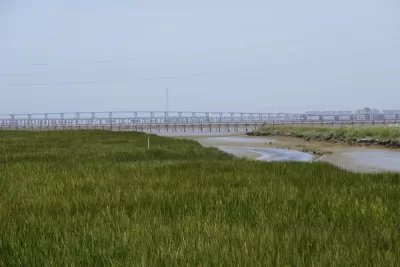Next month, along with picking presidential, U.S. Senate and legislative candidates, and local ballot measures in a primary election, voters in the Bay Area will also determine the outcome of the first regionwide measure in Bay Area history.

Credit: Ballotpedia. (Click here for expanded map [PDF].)
The measure is sponsored by a regional government agency that few in the Bay Area may be aware of: the San Francisco Bay Restoration Authority. Created by Assembly Bill 2954 in 2008, it "is a regional government agency charged with raising and allocating resources for the restoration, enhancement, protection, and enjoyment of wetlands and wildlife habitat in the San Francisco Bay and along its shoreline."
"Measure AA would implement a $12-a-year parcel tax, raising about half a billion dollars over 20 years," writes Lauren Sommer for KQED Science. "The money would go toward building up the bay’s defense against sea level rise by restoring [about 35,000 acres of] marshes."
“The marshes are a great buffer because the plants in the wetlands slow down the wave action and reduce the flooding,” says David Lewis, executive director of the non-profit Save the Bay.
Low-lying plants in tidal marshes, such as those on the Richmond shoreline, act like sponges, Lewis says, absorbing surges from big waves and floods.
Around 80 percent of the bay’s marshes have been lost since the Gold Rush, many paved over for development.
A "Highly" Regressive form of Property Tax
Unlike property taxes based on the assessed value of a property, parcel taxes are the same, whether it be be a mansion, of which there is no shortage of in the Bay Area, or a modest cottage, which will still cost you a pretty penny in most of the region.
A Unique Tax Measure
If the measure passes, it’ll be a first. Coastal cities like New Orleans have turned to federal grants to protect themselves. But raising money directly from the public for climate change could be a model for other coastal areas.
Unlike the two prior regional ballot measures that needed majority support, Measure AA would require a two-thirds threshold for passage.
The decision to place a ballot measure before Bay Area voters was made by the district’s governing board in a 6-0 vote in January, wrote Peter Fimrite for the San Francisco Chronicle.
For more information on the measure and the campaign, see "Yes on AA."
For SF Gate and San Francisco Chronicle (may be subscription-only) articles on the San Francisco Bay Restoration Authority and the tax measure dating back to 2008, click here (some may be subscription-only).
FULL STORY: Measure AA Asks Bay Area Residents to Help Protect Against Sea Level Rise

Alabama: Trump Terminates Settlements for Black Communities Harmed By Raw Sewage
Trump deemed the landmark civil rights agreement “illegal DEI and environmental justice policy.”

Study: Maui’s Plan to Convert Vacation Rentals to Long-Term Housing Could Cause Nearly $1 Billion Economic Loss
The plan would reduce visitor accommodation by 25% resulting in 1,900 jobs lost.

Why Should We Subsidize Public Transportation?
Many public transit agencies face financial stress due to rising costs, declining fare revenue, and declining subsidies. Transit advocates must provide a strong business case for increasing public transit funding.

Paris Bike Boom Leads to Steep Drop in Air Pollution
The French city’s air quality has improved dramatically in the past 20 years, coinciding with a growth in cycling.

Why Housing Costs More to Build in California Than in Texas
Hard costs like labor and materials combined with ‘soft’ costs such as permitting make building in the San Francisco Bay Area almost three times as costly as in Texas cities.

San Diego County Sees a Rise in Urban Coyotes
San Diego County experiences a rise in urban coyotes, as sightings become prevalent throughout its urban neighbourhoods and surrounding areas.
Urban Design for Planners 1: Software Tools
This six-course series explores essential urban design concepts using open source software and equips planners with the tools they need to participate fully in the urban design process.
Planning for Universal Design
Learn the tools for implementing Universal Design in planning regulations.
Smith Gee Studio
Alamo Area Metropolitan Planning Organization
City of Santa Clarita
Institute for Housing and Urban Development Studies (IHS)
City of Grandview
Harvard GSD Executive Education
Toledo-Lucas County Plan Commissions
Salt Lake City
NYU Wagner Graduate School of Public Service





























